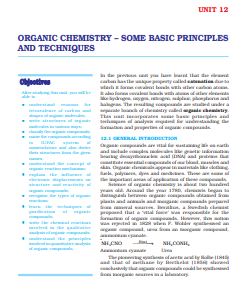‘NCERT Solutions for Class 11 Chemistry Chapter 12‘ PDF Quick download link is given at the bottom of this article. You can see the PDF demo, size of the PDF, page numbers, and direct download Free PDF of ‘Ncert Class 11 Chemistry Chapter 12 Exercise Solution’ using the download button.
Ncert Class 11 Chemistry Chapter 12 Exercise Solution PDF Free Download

Chapter 12: Organic Chemistry Some Basic Principles and Techniques
12.1 General Introduction
Organic compounds are vital for sustaining life on earth and include complex molecules like genetic information bearing deoxyribonucleic acid (DNA) and proteins that constitute essential compounds of our blood, muscles, and skin.
Organic chemicals appear in materials like clothing, fuels, polymers, dyes, and medicines.
These are some of the important areas of application of these compounds. The science of organic chemistry is about two hundred years old.
Around the year 1780, chemists began to distinguish between organic compounds obtained from plants and animals and inorganic compounds prepared from mineral sources.
Berzelius, a Swedish chemist proposed that a ‘vital force’ was responsible for the formation of organic compounds.
However, this notion was rejected in 1828 when F. Wohler synthesized an
organic compound, urea from an inorganic compound, ammonium cyanate.
12.2.1 The Shapes of Carbon Compounds
The knowledge of fundamental concepts of molecular structure helps in understanding and predicting the properties of organic compounds. You have already learned theories of valency and molecular structure in Unit 4.
Also, you already know that the tetravalence of carbon and the formation of covalent bonds
by it are explained in terms of its electronic configuration and the hybridization of s and p orbitals.
It may be recalled that the formation and the shapes of molecules like methane (CH4), ethane (C2H4), and ethyne (C2H2) are explained in terms of the use of sp3, sp2, and sp hybrid orbitals by carbon atoms in the respective molecules.
Hybridization influences the bond length and bond enthalpy (strength) in organic compounds.
The sp hybrid orbital contains more s character and hence it is closer to its nucleus and forms shorter and stronger bonds than the sp3 hybrid orbital.
The sp2 hybrid orbital is intermediate in s character between sp and sp3 and, hence, the length
and enthalpy of the bonds it forms are also intermediate between them. The change in hybridization affects the electronegativity of carbon.
The greater the s character of the hybrid orbitals, the greater the electronegativity. Thus, a carbon atom having an sp hybrid orbital with 50% s character is more electronegative than that possessing sp2 or sp3 hybridized orbitals.
This relative electronegativity is reflected in several physical and chemical properties of the molecules concerned, about which you will learn in later units.
| Author | NCERT |
| Language | English |
| No. of Pages | 39 |
| PDF Size | 30.2 MB |
| Category | Chemistry |
| Source/Credits | ncert.nic.in |
NCERT Solutions Class 11 Chemistry Chapter 12 Organic Chemistry: Some Basic Principles and Techniques
Question 12.1:
Draw formulas for the first five members of each homologous series beginning with the following compounds
(a) H–COOH
(b) CH3COCH3
(c) H–CH=CH2
Answer 12.6:
The first five members of each homologous series beginning with the given compounds are
(a)
H–COOH: Methanoic acid
CH3–COOH: Ethanoic acid
CH3–CH2–COOH: Propanoic acid
CH3–CH2–CH2–COOH: Butanoic acid
CH3–CH2–CH2–CH2–COOH: Pentanoic acid
(b)
CH3COCH3: Propanone
CH3COCH2CH3: Butanone
CH3COCH2CH2CH3 : Pentan-2-one
CH3COCH2CH2CH2CH3: Hexan-2-one
CH3COCH2CH2CH2CH2CH3 : Heptan-2-one
(c)
H–CH=CH2: Ethene
CH3–CH=CH2: Propene
CH3–CH2–CH=CH2: 1-Butene
CH3–CH2–CH2–CH=CH2: 1-Pentene
CH3–CH2–CH2–CH2–CH=CH2: 1-Hexene
Question 12.2:
What are electrophiles and nucleophiles? Explain with examples.
Answer 12.2:
A nucleophile is a reagent that has an electron pair and is willing to donate it. It is also known as a nucleus-loving reagent. Ex: NC–, OH–, R3C– (carbanions), etc.
An electrophile is a reagent that is in need of an electron pair and is also known as an electron-loving pair. Ex: Carbonyl groups, CH3CH2+(Carbocations), Neutral molecules (due to the presence of electron deficiency atom).
Question 12.3:
Identify the reagents shown in bold in the following equations as nucleophiles or electrophiles:
(a) CH3COOH + HO–\rightarrow→ CH3COO– + H2O
(b) CH3COCH3+ C–N \rightarrow→ (CH3)2C(CN) + (OH)–
(c) C6H5 + CH3C+O \rightarrow→ C6H5COCH3
Answer 12.3:
A nucleophile is a reagent that has an electron pair and is willing to donate it. It is also known as a nucleus-loving reagent.
An electrophile is a reagent that is in need of an electron pair and is also known as an electron-loving pair.
(a) CH3COOH + HO–\rightarrow→ CH3COO– + H2O
It is a nucleophile since HO- is electron-rich in nature.
(b) CH3COCH3+ C–N \rightarrow→ (CH3)2C(CN) + (OH)–
It is a nucleophile since C–N is electron rich in nature.
(c) C6H5 + CH3C+O \rightarrow→ C6H5COCH3
It is an electrophile since CH3C+O is electron-deficient in nature.
Organic Chemistry: Some Basic Principles and Techniques Textbook With Solutions PDF Free Download
